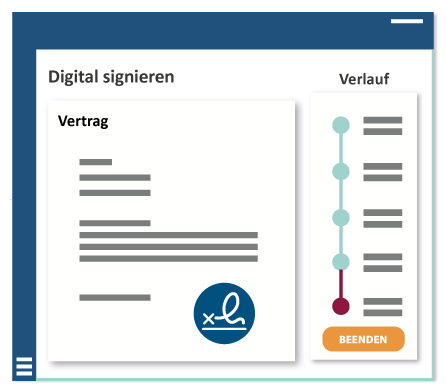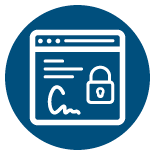Want to know more about ESCRIBA?
Simply register here for our e-mail distribution list.
Process efficiency, cost savings, sustainability – many good reasons for introducing a digital signature. Companies that take a holistic approach to their internal approval and signing processes achieve a whole new level of process optimization, compliance, and legal certainty.

* e-commerce-magazin
** d-velop
As the name suggests, the digital signature is a signature that is no longer given by hand on the printed document, but digitally – i.e., online. The electronic signature, as it is called in the legal context, fulfills the same purpose as a handwritten signature on a paper document: it serves to make the signing person identifiable and the integrity of the signed – electronic – information verifiable. As a rule, electronic signatures fulfill this purpose better than their analog counterparts, since the integrity is easier to verify and the person signing the document is easier to identify.
There is a lively debate as to whether, and if so in which cases, electronic signatures may be used instead of handwritten signatures on paper. You can read all about the current legal situation and recommendations for action for up-to-date and legally compliant use of electronic signatures in our whitepaper.
In many cases, these are documents that establish legal relationships. For this reason, the eIDAS Regulation has been in force since 2014. The core of the EU directive is electronic identification and transactions within the European area. Contracts can be signed in a legally binding manner purely electronically without having to print them out first. The eIDAS defines different types of digital signatures with different security levels. Not every digital signature can be used for all contracts or documents in a legally secure manner.

The simple electronic signature consists of data in electronic form and is linked to other electronic data. It is considered the weakest form and can be generated, for example, by inserting a scanned signature or confirming it by e-mail. This type is mainly suitable for transactions with low legal risk. For companies, it can therefore be used mainly for internal documents, such as the booking of a business trip.

The advanced electronic signature is created with a unique signature key. This is uniquely assigned to the signing person and thus enables electronic identification. The creation is based on the use of electronic signature creation data, which is used solely by the signing person and any change to the signed data is detected. The advanced signature is therefore suitable for business transactions with medium legal risk. In the B2B context, it provides an appropriate legal basis for offers and contracts.

The qualified electronic signature has the highest legal security and probative value. It is based on a qualified certificate, a secure signature creation device, and is suitable for transactions for which a handwritten signature is required by law – for example, employment contracts. For the signature to be recognized as qualified, the used certificate must be created by a qualified trust service. The qualified electronic signature is suitable for all documents and contracts for which the written form is required by law.

Electronic seals are used when legal entities, such as companies or public authorities, sign documents digitally. Instead of a natural person, such as an authorized signatory, the legal entity signs by issuing its electronic seal. This is like a digital company stamp that proves the integrity and origin of the document. Recipients can trust that the electronic document was issued by the corresponding organization and is genuine.

Project Manager at ENERCON GmbH
The use of electronic signatures in the company represents a gain in efficiency, as contracts can be signed by multiple parties in the blink of an eye. There is great potential for savings here, as not only time but also costs for paper, printing and mailing are eliminated.
Companies that are considering the introduction of digital signatures should take a closer look at the entire issue of authorization and competencies. A company-wide analysis of signature processes makes it clear that much more is signed than is required. Although digital signatures are significantly less expensive per unit, they also generate costs. Internal processes do not necessarily require a signature. A simple approval, for example in the form of a checkbox, is often sufficient. Nowadays, this process can be represented in a technically very simple and comprehensible way.
It must be ensured that the person signing is authorized for the signature process and has the appropriate competencies. This clarity about the company’s internal authorizations must be given for all processes – even more so when signing a contract.
That is why we recommend that companies create a competence and signature database as a first step. Along the organizational structure, it is defined who may release and sign which documents and what form is required for this. If this signature directory is now mapped digitally, multi-level processes and approval instances can also be automated with workflows.
Document Signing and Approval Manager (DSAM) lets you document authorization-driven approvals and manage digital signature processes for all documents and contracts.
The ESCRIBA Document Signing and Approval Manager provides you with exactly these functions. In addition, our No-/ Low-Coding App ensures that all data relating to the signature status – for example, the type of release or signature used, the authorization in place, the person signing, etc. – can be clearly displayed, permanently documented, and specifically evaluated
In general, all types of contracts are free of formal requirements. Exceptions, such as employment contracts, are regulated by law and must be signed with a qualified electronic signature under German law. In terms of legal certainty, however, this is always recommended if there is to be incontestable traceability to the signatory or if a handwritten signature is used analogously.
Companies must ultimately decide for themselves whether and which form of electronic seal or electronic signature they want to use for legitimation and authentication. Digital signatures – regardless of their form – should not be implemented merely for the sake of technology. The positive effect on the efficiency of everyday work processes and the possibility of significantly simplifying and accelerating them should be at the forefront of the decision-making process.




We advise you comprehensively on all steps and analyses in the context of digital signatures, signature and authorization directories, and the implementation of document governance. In addition, you can implement a comprehensive technical solution for your company with our ESCRIBA Document Signing and Approval Manager (DSAM).
DSAM runs on our no/low code platform. This means that the app can be quickly adapted or extended to your needs at any time. Our platform is fully integration-ready, and we can easily connect existing systems or signature providers via our interfaces. This means that you not only benefit from a fast go-live but can also react immediately to changes and feedback. Document templates, processes and system integrations can be adapted and improved in near real-time.
If desired, we maintain and operate your applications in our cloud and optimize your processes according to your requirements. This creates better business software in an agile process that remains permanently up to date.


Why ESCRIBA?
ESCRIBA stands for 25 years of living digitalisation in companies. Our heart beats for digital processes and scalable technologies, which we develop on our own no- and low-code platform. With this, we create groundbreaking results in a short time and bring your software world up to speed. Choose from our wide range of pre-packaged solutions or let us develop customised software for your personal use. more >>
Want to know more about ESCRIBA?
Simply register here for our e-mail distribution list.